2021 Ford Bronco and Bronco Sport
#301
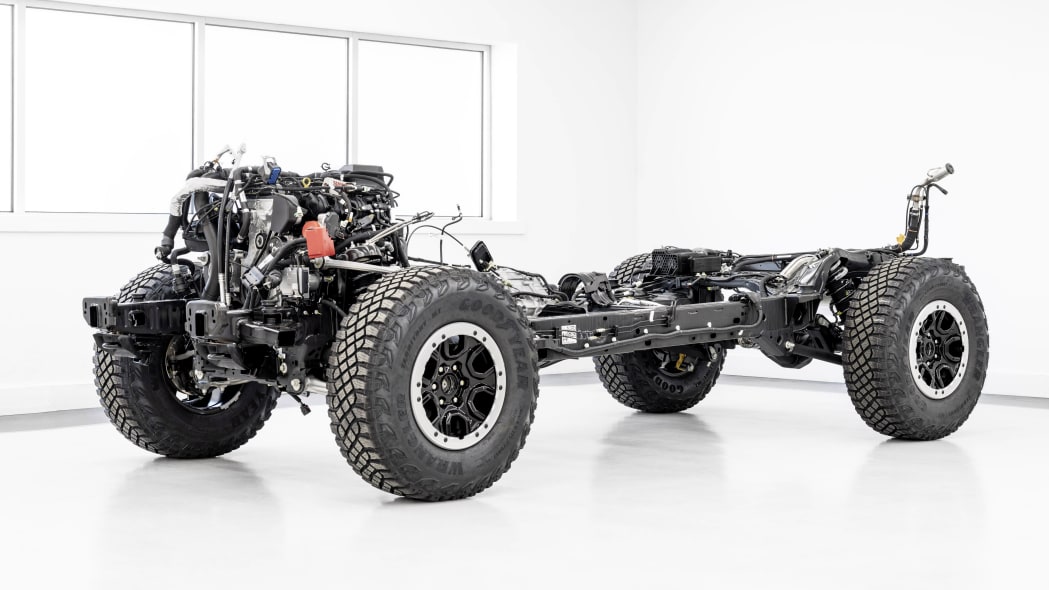
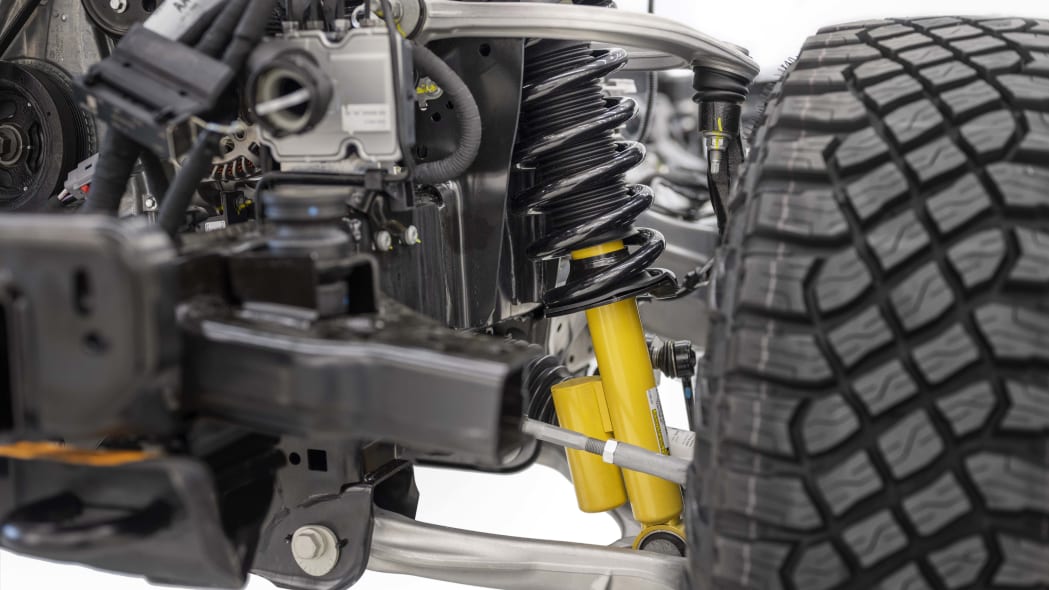

Ford hasnít released all of the new Bronco suspension details Iíd like to see, but I did learn enough to come away impressed. OK, Iíll admit it. They can have my $100 deposit right now. Iím saying this because they seem to have hit a target that lies smack in the middle of the off-roaderís conundrum. Well, my personal conundrum, at least. Should I buy a Jeep Wrangler or a Toyota 4Runner? I punted and somehow ended up with one of each. If Bronco had been available earlier, I wouldnít be in this predicament.
What Ford has come up with is what would have been my sweet spot: an open-air capable off-roader, but with a full-width cabin and independent front suspension to make it more livable on road and presumably (because I havenít driven it) less bone-jarring on the sorts of washboarded overland-type trails I tend to explore. Iíll be the first to admit Iím not a double black-diamond thrillist. That said, useful Rubicon-esque off-road tools are available. But I also see more than a little of the fabled and forbidden Ranger Raptor in the new Bronco as well.
If this talk makes you worry about narrow trails, know that the Badlands (and all the rest) have a track width of 65 inches. Thatís 1.8 inches broader than a 4Runner, but the Broncís tighter body sculpting makes the Badlands just a half-inch wider overall than the Toyota. The new Fordís tires simply fill out its wheel wells better, is all. You get the on-road benefits and good looks of a wider track without much increase in trail damage peril.
The control arms donít look to be a direct carryover, but here itís hard to be certain. The upper one might be. But the stabilizer bar positioning and link routing looks very different in a way that suggests that the Broncoís knuckle and lower control arm will be unique. This is probably due to the space needed to package the new disconnectable front stabilizer bar, but thatís a guess.
That said, the Badlands four-doorís estimated maximum RTI (ramp travel index) score of 620 points with the bar disconnected is quite a bit better than the last KDSS-equipped 4Runner I measured on my own ramp. I have a feeling that a Wrangler Rubicon Unlimited will score better, but the estimated Bronco Badlands number is still quite solid.
Broncoís Bilsteins have remote reservoirs that increase oil volume for cooler running, and they also have internal hydraulic end stops that give them position-sensitive damping. Theyíll be soft in the middle of their travel and firm up to the ends to soak up big hits with less chance of bottoming or topping out. The end-stop concept is similar to what youíd find on an early TRD Pro Tundra, but that truckís Bilsteins didnít have the additional benefit of remote reservoirs.
Both have a solid rear axle thatís located by four trailing links, and they both use a coil-over rear spring/damper configuration. Iím not seeing any appreciable difference where the upper end of the spring/shock mounts to the frame, and the lower trailing link looks mighty similar, too. The difference comes down to lateral control, and it's a clear departure. The Ranger Raptor uses a Watts linkage, while the Bronco uses the more familiar (and undoubtedly less costly) lateral panhard rod.
If those ratios sound generally high, these tire diameters are generally large and this vehicle will have a 10-speed automatic with a highly overdriven 0.646-to-1 top gear. The new seven-speed manual is right in the same ballpark with a 0.636-to-1 cruiser gear. Of course seventh gear is really sixth because second is really first. Thatís because theyíre calling first gear Crawler, a name it truly deserves because its 6.588-to-1 ratio wonít be useful in daily driving.
Because of that creepy crawly gear, Ford is touting a mighty 94.75-to-1 crawl ratio when the manual transmission is paired with the 4.7-to-1 axle ratio. That combination seems to be available on a Badlands with 33-inch tires, which in my mind adds up to an uncommonly low trail walking speed at idle.
Iíve got my eye on the Badlands. Itís the only one with a disconnectable front stabilizer bar, but it also has the front and rear locking differentials. It has the most suspension travel by far, and it will absolutely be the one that travels farthest up my Flex Index ramp. I also like the fact that the Badlands has the HOSS Bilstein suspension. It comes with the higher-grade electromechanical transfer case that has a lower 3.06-to-1 low-range ratio, but I wouldnít have lost sleep over that even if it didnít because the base electronic shift-on-the-fly (ESOF) transfer case has a 2.72-to-1 that isnít terribly far off. Itís nothing like the 4-to-1 versus 2.72-to-1 situation over at Jeep.
The Wildtrak was described to me by a Ford representative as a desert runner, and a lot of that has to do with its bonkers 35-inch tires. But Iím not convinced Iíd want the biggest tire because their very size made it necessary to limit suspension travel and forgo the disconnectable stabilizer bar so the 35-inchers wonít rub. This version will not be the RTI standout of the bunch, but it will be able to get itself out of most trouble because of its front and rear lockers.
Still, Iím a suspension flex snob, so Iíll stick with the Badlands and its longer suspension travel, disconnectable front stabilizer bar and the 33-inch tires that makes those bits workable. Ford hasnít released approach, departure and ground clearance that specifically apply to the Badlands, but theyíll be closer to the Wildtrak end of the spectrum. I estimated 10.5 inches of Badlands ground clearance by considering its smaller tire radius and hacking one inch off the Wildtrakís ground clearance figure. That puts it smack in the ballpark with Rubicon and much better than 4Runner.
And thatís exactly what Iím seeing up and down the preliminary Bronco spec sheet. This is a vehicle that combines attributes of both the Jeep Wrangler and the Toyota 4Runner into one vehicle. And Iím all in before factoring in the superior EcoBoost engines and the new Sync 4 infotainment system. Take my $100 right now. Iím getting in line.
What Ford has come up with is what would have been my sweet spot: an open-air capable off-roader, but with a full-width cabin and independent front suspension to make it more livable on road and presumably (because I havenít driven it) less bone-jarring on the sorts of washboarded overland-type trails I tend to explore. Iíll be the first to admit Iím not a double black-diamond thrillist. That said, useful Rubicon-esque off-road tools are available. But I also see more than a little of the fabled and forbidden Ranger Raptor in the new Bronco as well.
The suspension footprint is really wide
The first thing that jumped out at me was the track width of the suspension. Itís much wider than the Ford Ranger (61.4 inches) that we know. The Bronco Wildtrak has a track width of 66.9 inches, which is a scant 0.4 inches narrower than the Ranger Raptor we donít get here. But track width numbers donít tell the whole story because they are measured at the middle of the tread. The 35Ē tires that come on Wildtrak are 315 mm wide instead of the small Raptorís 285 mm, so the Bronco Wildtrak is in fact slightly broader than a Ranger Raptor from tire sidewall to tire sidewall.If this talk makes you worry about narrow trails, know that the Badlands (and all the rest) have a track width of 65 inches. Thatís 1.8 inches broader than a 4Runner, but the Broncís tighter body sculpting makes the Badlands just a half-inch wider overall than the Toyota. The new Fordís tires simply fill out its wheel wells better, is all. You get the on-road benefits and good looks of a wider track without much increase in trail damage peril.
The front suspension is new
Fleeting images of the Broncoís bare chassis hint at why it has such a wide stance. The shots clearly show aluminum upper and lower control arms, but they also show a more robust structure where the upper shock mount meets the inner pivot of the upper control arm. Comparing that to similar images taken at the Ranger Raptor introduction, I could easily believe the frame-side suspension mounting points are the same. Itís certainly not lifted from our normal Ranger.The control arms donít look to be a direct carryover, but here itís hard to be certain. The upper one might be. But the stabilizer bar positioning and link routing looks very different in a way that suggests that the Broncoís knuckle and lower control arm will be unique. This is probably due to the space needed to package the new disconnectable front stabilizer bar, but thatís a guess.
The disconnecting front stabilizer bar is pretty rad
Ford says its stabilizer bar can be connected and disconnected under load, and that should make it faster-acting than the one thatís fitted to a Jeep Rubicon. Weíve all seen the Sway Bar status light flash in a Jeep as it waits until the truck is on a flat-enough surface before the operation can be completed, but what Ford is saying suggests that such delays will be short-lived to non-existent in a Bronco.That said, the Badlands four-doorís estimated maximum RTI (ramp travel index) score of 620 points with the bar disconnected is quite a bit better than the last KDSS-equipped 4Runner I measured on my own ramp. I have a feeling that a Wrangler Rubicon Unlimited will score better, but the estimated Bronco Badlands number is still quite solid.
More front and rear locking differential options
The Wildtrak and Badlands come with front and rear lockable differentials, and theyíre easy to add to any other trim by adding the Sasquatch package. But thereís more to them than their seemingly wide availability. Ford tells me that a driver can choose to lock the rear one in 2-Hi mode, and that the front one can be locked by itself in 4-Lo mode. Normally, factory-installed front differentials are lockable only after the rear one is locked first, but the Bronco is set up to offer more driver control.HOSS Bilsteins look promising
The High-Performance Off-Road Stability Suspension (HOSS) comes on the Wildtrak and Badlands, and these are also available on any other trim if you buy the Sasquatch package. The use of Bilstein shocks is a departure from the Fox shocks used on the Range Raptor, but I wouldnít read too much into that.Broncoís Bilsteins have remote reservoirs that increase oil volume for cooler running, and they also have internal hydraulic end stops that give them position-sensitive damping. Theyíll be soft in the middle of their travel and firm up to the ends to soak up big hits with less chance of bottoming or topping out. The end-stop concept is similar to what youíd find on an early TRD Pro Tundra, but that truckís Bilsteins didnít have the additional benefit of remote reservoirs.
More Ranger Raptor at the rear
If anything, the rear half of the Broncoís suspension looks more like a Ranger Raptor than the front. The RR differs from all other Rangers because it uses coil spring rear suspension, and that truck seems to be piloting a new rear configuration that will appear elsewhere. The Bronco seems to be the first use of that suspension layout on these shores.Both have a solid rear axle thatís located by four trailing links, and they both use a coil-over rear spring/damper configuration. Iím not seeing any appreciable difference where the upper end of the spring/shock mounts to the frame, and the lower trailing link looks mighty similar, too. The difference comes down to lateral control, and it's a clear departure. The Ranger Raptor uses a Watts linkage, while the Bronco uses the more familiar (and undoubtedly less costly) lateral panhard rod.
There are lots of tire sizes and axle ratios
The Bronco will be offered with tires of four diameters: 30, 32, 33 and 35 inches. Within that, the 32-inch tire is available in three distinctly different sizes. That adds up to six different tire sizes in all. Along with that, there are four axle ratios: 3.73, 4.27, 4.46 and 4.70-to-1. Generally speaking, axle ratios will be matched up with tire diameter to keep the effective overall gearing similar, but the presence of both an automatic and a manual transmission means itís not quite as simple as that.If those ratios sound generally high, these tire diameters are generally large and this vehicle will have a 10-speed automatic with a highly overdriven 0.646-to-1 top gear. The new seven-speed manual is right in the same ballpark with a 0.636-to-1 cruiser gear. Of course seventh gear is really sixth because second is really first. Thatís because theyíre calling first gear Crawler, a name it truly deserves because its 6.588-to-1 ratio wonít be useful in daily driving.
Because of that creepy crawly gear, Ford is touting a mighty 94.75-to-1 crawl ratio when the manual transmission is paired with the 4.7-to-1 axle ratio. That combination seems to be available on a Badlands with 33-inch tires, which in my mind adds up to an uncommonly low trail walking speed at idle.
Badlands is to Rubicon as Wildtrak is to Mojave
Looking at the equipment, it seems to me that the Badlands is the one to get if youíre a Rubicon person, and the Wildtrak is more akin to what a Jeep Wrangler Mojave would be if they ever got around to building one. Thereís also the First Edition, of course, but letís set aside that limited launch model thatís a bit of both.Iíve got my eye on the Badlands. Itís the only one with a disconnectable front stabilizer bar, but it also has the front and rear locking differentials. It has the most suspension travel by far, and it will absolutely be the one that travels farthest up my Flex Index ramp. I also like the fact that the Badlands has the HOSS Bilstein suspension. It comes with the higher-grade electromechanical transfer case that has a lower 3.06-to-1 low-range ratio, but I wouldnít have lost sleep over that even if it didnít because the base electronic shift-on-the-fly (ESOF) transfer case has a 2.72-to-1 that isnít terribly far off. Itís nothing like the 4-to-1 versus 2.72-to-1 situation over at Jeep.
The Wildtrak was described to me by a Ford representative as a desert runner, and a lot of that has to do with its bonkers 35-inch tires. But Iím not convinced Iíd want the biggest tire because their very size made it necessary to limit suspension travel and forgo the disconnectable stabilizer bar so the 35-inchers wonít rub. This version will not be the RTI standout of the bunch, but it will be able to get itself out of most trouble because of its front and rear lockers.
Still, Iím a suspension flex snob, so Iíll stick with the Badlands and its longer suspension travel, disconnectable front stabilizer bar and the 33-inch tires that makes those bits workable. Ford hasnít released approach, departure and ground clearance that specifically apply to the Badlands, but theyíll be closer to the Wildtrak end of the spectrum. I estimated 10.5 inches of Badlands ground clearance by considering its smaller tire radius and hacking one inch off the Wildtrakís ground clearance figure. That puts it smack in the ballpark with Rubicon and much better than 4Runner.
And thatís exactly what Iím seeing up and down the preliminary Bronco spec sheet. This is a vehicle that combines attributes of both the Jeep Wrangler and the Toyota 4Runner into one vehicle. And Iím all in before factoring in the superior EcoBoost engines and the new Sync 4 infotainment system. Take my $100 right now. Iím getting in line.
#302
A Bronco without the ability to remove the roof and doors ó a hallmark of the original 1966 model ó wouldn't be much of a Bronco at all. And so Ford decided to approach the 2021 Bronco's exterior with one key notion in mind: modularity.
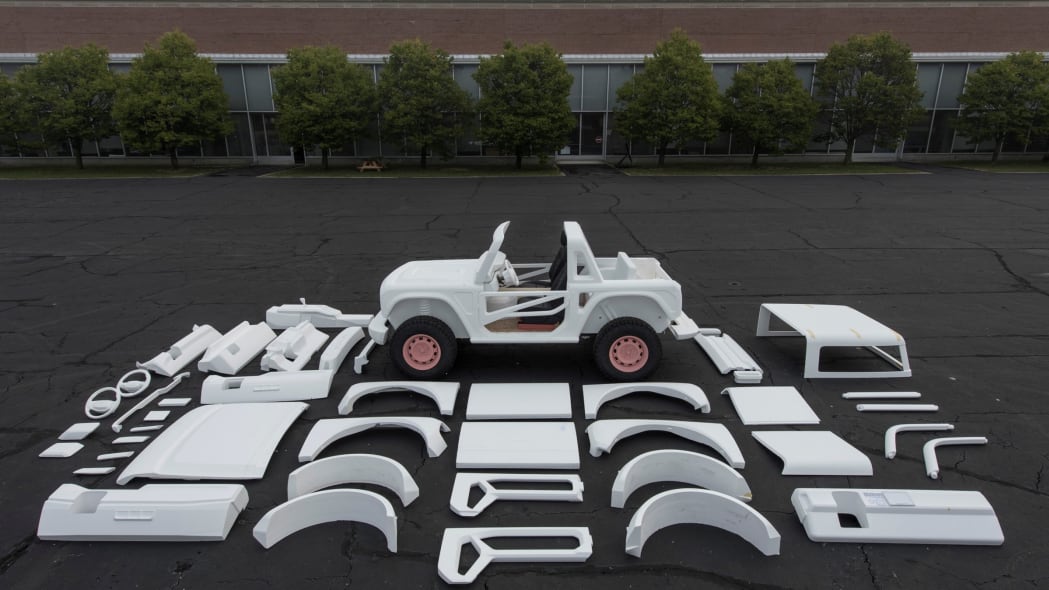
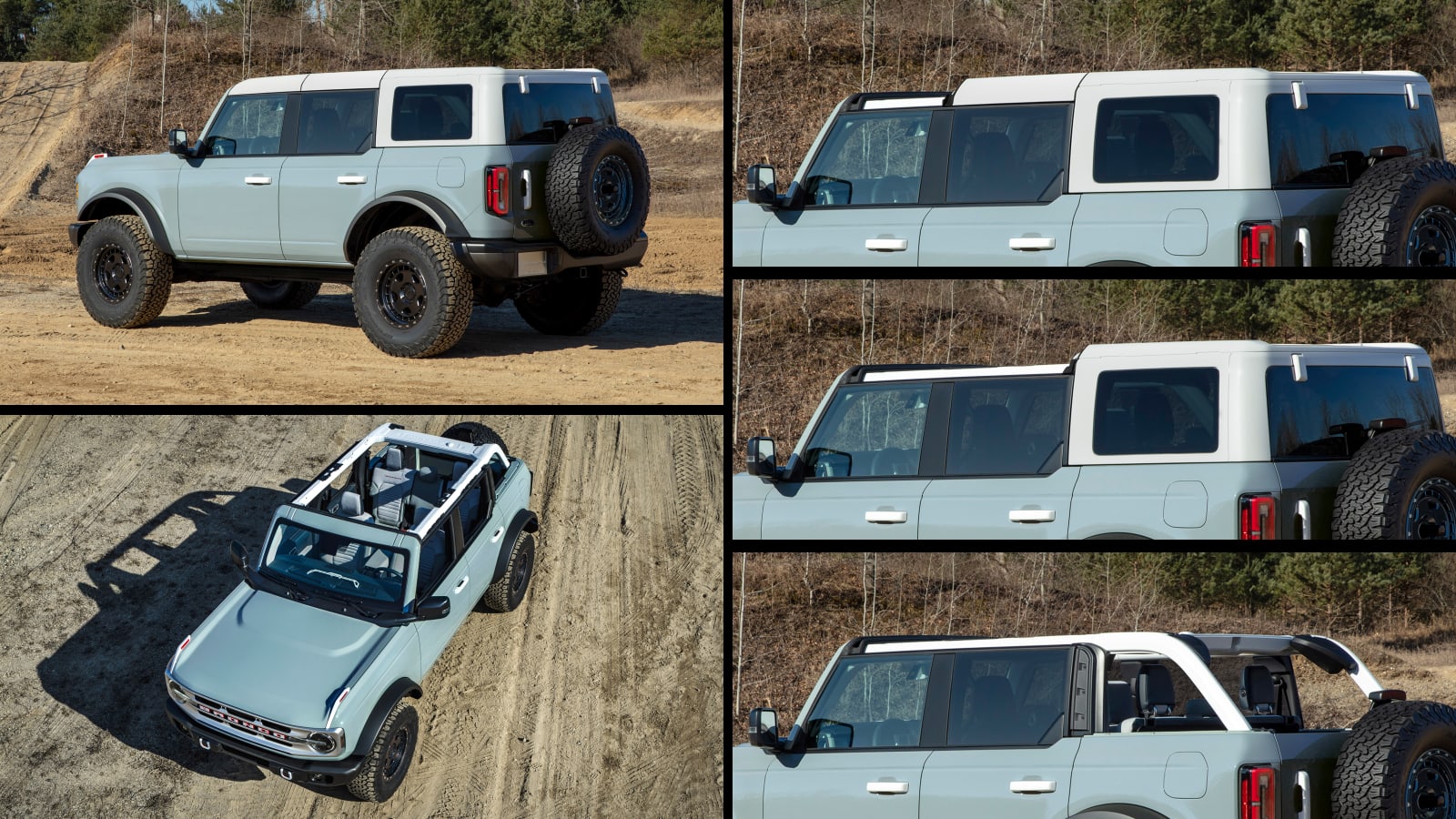
More pictures of modular body and Source
#303
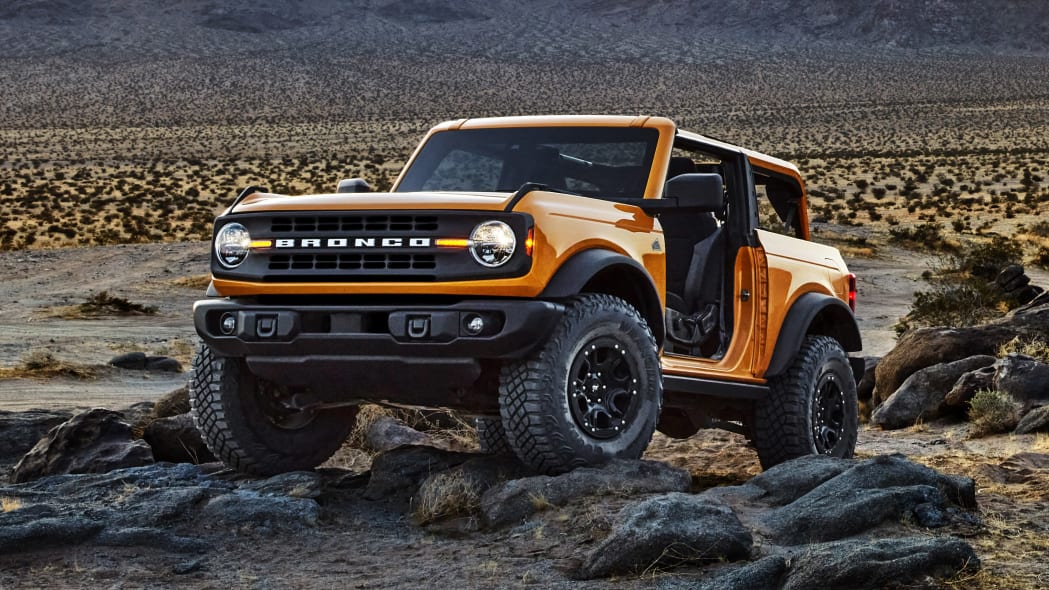
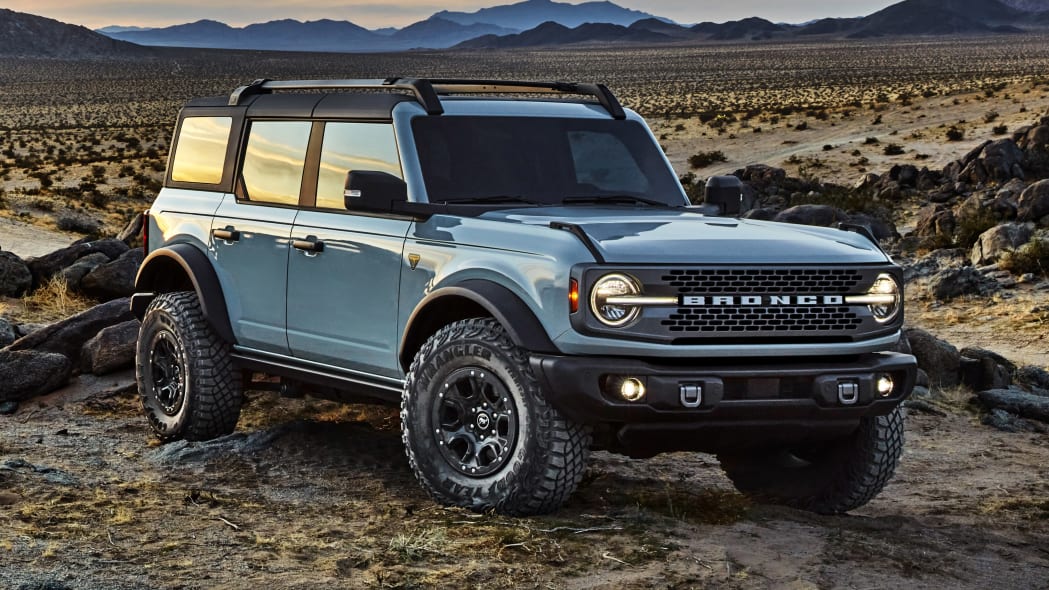
Frame, suspension and clearances
The new Bronco rides on a fully boxed, high-strength steel frame that will be shared with and adapted for the next-generation Ford Ranger. It has an independent front suspension with twin alloy A-arms and coil-over springs, while the rear is a solid axle with five links and coil-overs. This is the key mechanical difference between the Bronco and Wrangler, as the Jeep has a live axle in the front and rear.Despite the independent front end, Ford insists the Bronco can have 17% more suspension travel than the Wrangler (sorry, its "closest competitor") and the top Badlands trim has a hydraulically controlled stabilizer bar that can distinctively be disconnected when on an angle and under load. There are also Bilstein position-sensitive dampers, intended for higher-speed, desert-running use, available with the "High Performance Off-Road Stability Suspension" or HOSS.
Clearances depend on trim level, number of doors and, crucially, whether you outfit the Bronco in question with the segment-exclusive 35-inch tire option. There's at least 8.3 inches (Four-Door) or 8.4 inches (Two-Door) to start, but the big wheels bump it up to 11.5 and 11.6, respectively. The Jeep Wrangler starts off higher at 9.7, but tops out at 10.8 for the Rubicon.
The approach angle is 35.5 degrees for both body styles (43.2 with the big tires). The breakover angles are 21.1 degrees (29.0 with big tires) for the Two-Door and 20.0 (26.3) for the Four-Door. The departure angles are 29.8 degrees (37.2) for the Two-Door and 29.7 (37.0) for the Four-Door. In short, the base numbers are broadly less than what a base Wrangler can accomplish, but with the big tires, the Bronco can not only surpass a base Wrangler but effectively match the most capable Wrangler Rubicon.
Powertrains
There are two available engines, both of which put up impressive numbers. The standard 2.3-liter turbocharged inline-four, shared with the Ford Ranger, produces a stout 270 horsepower and 310 pound-feet of torque. Then there's the heavy artillery: a 2.7-liter turbo V6 good for 310 hp and 400 lb-ft of torque, which betters the 2.7 offered in the Ford F-150 and just about blows away every Wrangler engine. The only exception is the Wrangler's diesel V6 that makes 442 pound-feet of torque, but its 260 horsepower is shy of both Ford engines.Standard on the 2.3-liter is technically a seven-speed manual transmission, but it's not like the one you'd find in a Porsche 911 or C7 Corvette. Instead, it's effectively a six-speed manual with a crawler gear that, when equipped with the upgrade 4x4 system and its electromechanical transfer case, can achieve a crawl ratio of 94.75:1. For some comparison, the base 4x4 system with the automatic can best achieve a ratio of 57.19:1.
Speaking of the automatic, its Ford's now-familiar 10-speed that's optional on the 2.3-liter and standard with the 2.7 liter. So no, you can't get the big motor with the manual. Commence complaints. The automatic's best crawl ratio is 67.8:1.
Four-wheel drive is standard on every Bronco, but there are two systems. The standard system features a two-speed, electronic, shift-on-the-fly transfer case with a 2.71:1 low ratio, while the optional system has a a 3:06:1 low ratio and adds a 4A mode that automatically goes between 2H and 4H when needed. This has been seen previously on other Ford trucks and SUVs.
The differentials are produced by Dana, with the rear being a Dana 44, with standard AdvanTEK units and available Spicer Performa-TraK electronic locking units.
Off-road tech
All of the above was tested to a higher standard than the usual "Built Ford Tough" regimen applied to the company's truck offerings. Dubbed "Built Wild Extreme Durability Testing," it included extensive off-roading on King of the Hammers trails and was done to make sure the new Bronco satisfied the revived "Go Over Any Terrain" or GOAT mantra originally concocted for the original Bronco back in the 1960s.We largely mention that to explain why the Bronco has something called GOAT modes. Like other terrain-specific vehicle modes offered by Jeep, Land Rover and others, these alter various mechanical components and vehicle settings based on the driver's selection. Depending on trim level there can be seven in total: Normal, Eco, Sport, Slippery and Sand, plus Baja, Mud/Ruts and Rock Crawl.
Also offered is Trail One-Pedal Drive intended to improve precision and increase confidence while rock crawling, as well as Trail Control, the low-speed off-roading cruise control system that we found works well in the Ford Ranger. More intriguing is the Trail Turn Assist that effectively uses 4x4 torque-vectoring to tighten turning radii.
To make things even easier when venturing off the beaten path, an available 360-degree camera system is enhanced with cameras at each front wheel to help you spot yourself. There are also more than 1,000 curated topographic trail maps available with either the standard 8-inch or optional 12-inch touchscreens that can work with or without internet access.
And finally, those touchscreens operate using the latest Sync 4 software/interface. It's a substantially quicker system, and among its feature upgrades are wireless Apple CarPlay and Android Auto. It can also be updated over the air, albeit only when the owner chooses.
Roofs and doors
When Ford was doing market research for the new Bronco, it was clear that potential buyers wanted the ability to remove the roof and doors. You know, like a Wrangler.The Bronco Two-Door, which is expected to sell in far fewer numbers, is available only with a hardtop. However, there is still a choice. The standard roof has three removable sections: two over the front occupants that can be safely stored in the trunk and a large rear section that'll have to stay behind. The premium painted option gains a fourth section, a removable panel that spans the rear seats and cargo area. It's also big to fit in the cargo area.
The Bronco Four-Door comes standard with a cloth soft top, but you don't have to choose between it and the optional four-section hardtop ó owners can keep both. It should also be noted that there is no cross brace between the B pillars as in the Wrangler (it's behind the back seat instead), allowing for an uninterrupted view of the heavens with the roof panels removed.
The doors can be removed as in the Wrangler, but there are innovations. While developing the Bronco, Ford's designers noticed Jeep doors chained to trees or just lying about trails. They also wondered "what if the owner doesn't have a garage?" Their answer to the problem: the Bronco's doors have frameless windows and are therefore smaller, making it possible to stow them in the Four-Door's cargo area complete with storage bags. (We assume this is not possible in the Two-Door as Ford specifically called out the Four-Door). The smaller size should also make them lighter and less cumbersome to remove, although by how much we'll have to wait and see.
There's also the matter of mirrors. On the Wrangler, when you take off the doors you're also getting rid of the side mirrors. The Bronco's are mounted to the body.
There will also be different door designs available as accessories, which are just some of the hundreds of customization opportunities that will be possible with the 2021 Bronco. According to head designer Paul Wraith, "With one hour and a wrench, you can strip this truck down," referring to the body panels that can easily be removed. He specifically noted that the fender flares come off in seconds, while the bumper end caps can be removed for greater wheel clearance. Basically, the Bronco is modular.
We received some mixed information about how much of this capability is intended for customization and how much is simply to make repairs easier. Itís something we'll be investigating for future posts.
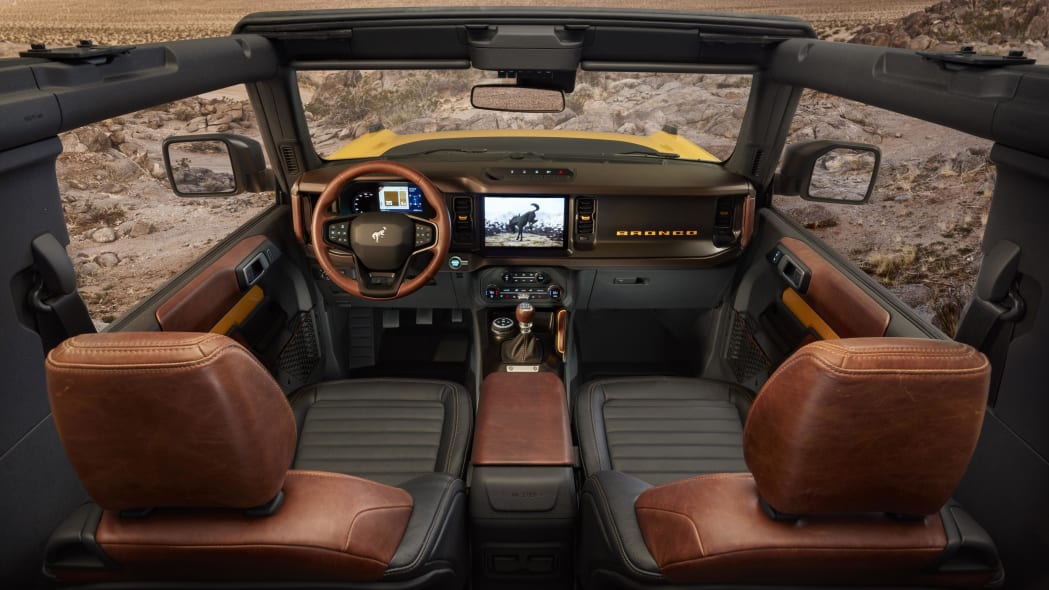
A new kind of design process
Designer Paul Wraith's team literally started by scanning the original-generation Bronco owned by Ford's VP of Design Moray Callum in order to properly study the classic SUV's packaging. It would also use that original Bronco to establish the key basic design elements of both the 2021 Bronco and the Bronco Sport crossover: a simple grille with two round headlights intersected by a Bronco-branded trim strip, an arrow-straight line down the sides, and a horizontal trim piece at the rear bookended by simple vertical taillights. The result is unquestionably clean, purposeful, and as the original, likely to age very well.Beyond the looks, however, Wraith decided to do things differently in designing the Bronco.
"It's not the normal approach," he said. "But we haven't done something weird in ages."
The team used working, useable scale models they could climb into, take apart and swap on new pieces. There were many comparisons to building with Lego during the press briefings. Those working models were then used in conjunction with extensive VR testing and were even mounted on inclines to see how various functions might behave when off-roading. This led to the design of grab handles located on the center console and at the ends of the dash that are removable and replaceable on most trim levels. It was also where the available dash-top device rack was devised and designed. Pictured below right, it provides a place to securely mount smartphones, GoPros or whatever without suction cups.
Besides the working models, the designers also mixed things up by using story-board-like drawings to identify how people might actually use the Bronco. This led to things like a bottle opener in the cargo area and an available slide-out panel in the cargo floor that effectively turns into an open tailgate
Indeed, real-world functionality was the driving force behind the entire design.
"There's nothing on this truck that's superfluous," Wraith said. "Function not fashion. Everything is exactly where you would need it."
Take the "trail sights" as one example. They're obviously a nifty styling flourish, but they serve real purposes by helping the driver ID the SUV's corners while maneuvering off-road and as tie-down points for securing things to the roof without damaging the paint or lights.
Seven series
You may consider them trim levels if you wish, but Ford prefers "all-new experiential-based equipment series." Whatever. There are seven of them with all but the "Base Bronco" having outdoorsy trademarked names that go far beyond the usual XLT and Limited variety. And no, one isn't Eddie Bauer.The Base is described as the one for purists who'd buy a new '66 Bronco if they could. It'll start at $29,995, including destination, for a Two-Door model. Note that's the only price available at this time.
We'll have a complete post breaking down the seriesí content, but in short, Big Bend adds greater off-road capability and more creature comforts. Black Diamond basically adds more rugged attire: heavy-duty bumpers, skid plates, a wash-out and drainable rubber floor, and marine-grade vinyl upholstery that resists water and mold. The Outer Banks is the fancy one with high-gloss trim, a B&O sound system, the 12-inch touchscreen standard, etc.
There are then two harder-core offerings that fork in two off-roading directions. The Bronco Wildtrak is intended for high-speed desert running (not unlike the Gladiator Mojave), and includes the Bilstein dampers and 2.7-liter engine as standard. The Bronco Badlands, meanwhile, gets the full rock-crawling menu of mechanical upgrades, the Black Diamond's tough stuff and the Outer Banks' fancy stuff. Basically, itís the answer to Jeep's Rubicon.
However, you don't have to get one of the pricy Bronco trim levels to get their extra off-roading equipment. The Sasquatch Package (yes it's really called that) adds the more advanced 4x4 system, upgraded tires, HOSS suspension and locking diffs. Only the disconnecting stabilizer bar is missing.
All trims also come standard with a pass to one of the four Bronco Off-Roadeo experience sites that provide owners with hands-on instruction to match their level of off-roading experience.
#304
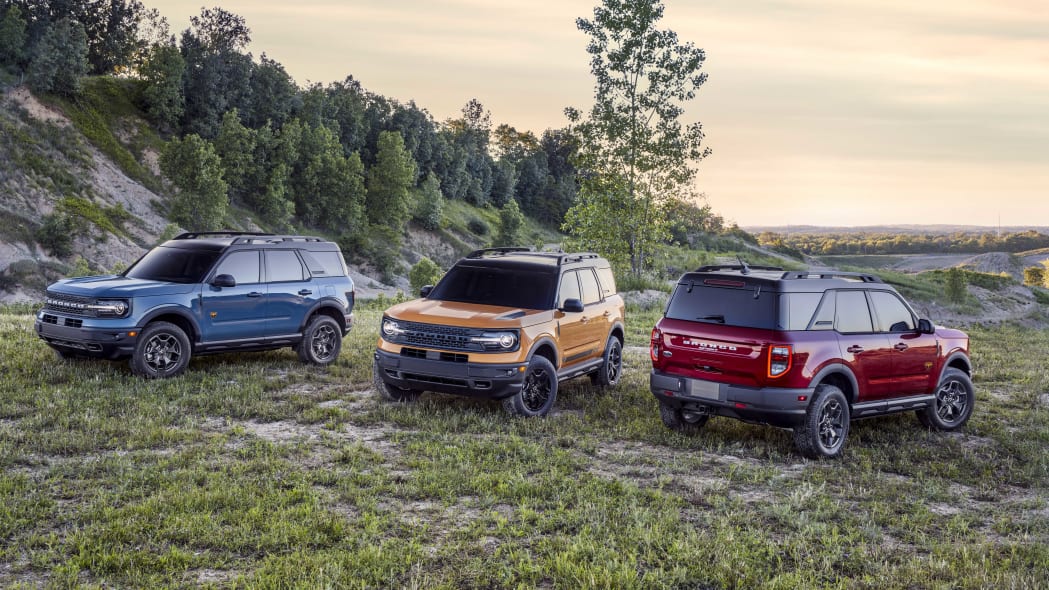
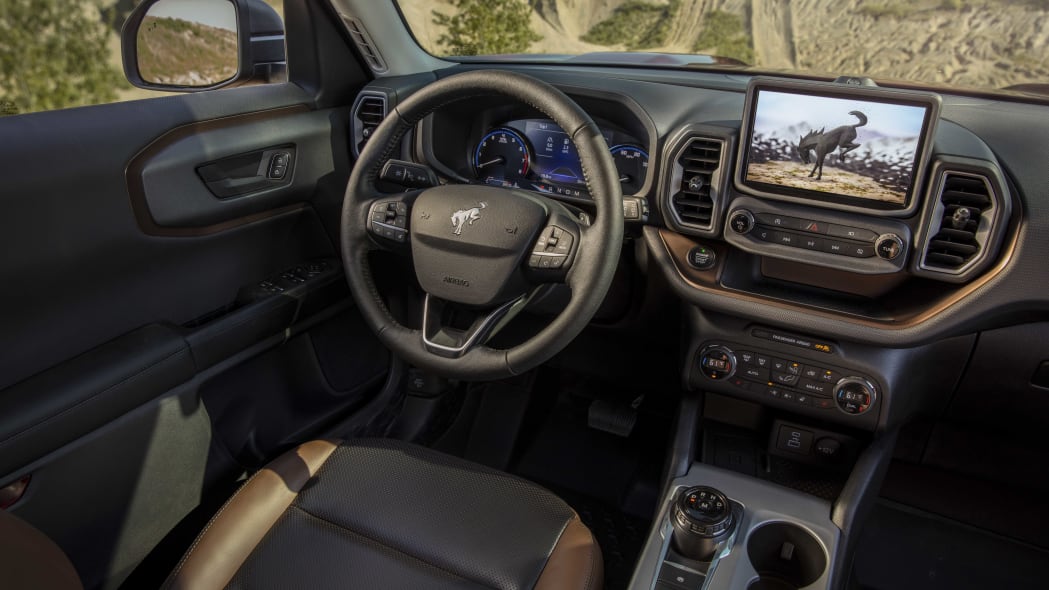
There will be those who dismiss the 2021 Ford Bronco Sport as the knockoff crossover Bronco for poseurs. However, now that we know the specs, have learned more about its capability, and recognize that it was thoughtfully designed with the needs of a different outdoorsy sort in mind, we think it'll be a lot harder to knock Ford's well-rounded effort here.
A full-size spare tire is standard. So too are big, rugged roof racks that include tie-down cutouts. They, along with the roof itself, are strong enough to accommodate a roof-mounted tent and were designed specifically with a variety of racks in mind. The liftgate features large grab handles that serve double duty as a drying rack and a pair of standard LED "floodlights" that bathe up to 129 square feet, making it easier for the cargo area to serve as a base camp. It also has a separate flip-up window and apparently raises higher than normal for fewer clonked heads (though an actual height number for comparison wasn't provided).
A different Bronco buyer
First, there's an important distinction to be made. Just because you don't do hardcore off-roading with your SUV doesn't mean you don't actually use it outdoors. As Ford correctly pointed out in its pre-reveal press presentation, people treat their vehicles as another vital piece of gear they take on various outdoor adventures. This may seem like marketing shlock, but as someone who lives in the Pacific Northwest where roof racks abound and the neighbors' SUVs return on Sunday evening dirty from a weekend away, this is absolutely real. Let's call it the REI buyer. It's the sort who typically turns to Subaru, and who Ford is targeting directly with the Bronco Sport.A full-size spare tire is standard. So too are big, rugged roof racks that include tie-down cutouts. They, along with the roof itself, are strong enough to accommodate a roof-mounted tent and were designed specifically with a variety of racks in mind. The liftgate features large grab handles that serve double duty as a drying rack and a pair of standard LED "floodlights" that bathe up to 129 square feet, making it easier for the cargo area to serve as a base camp. It also has a separate flip-up window and apparently raises higher than normal for fewer clonked heads (though an actual height number for comparison wasn't provided).
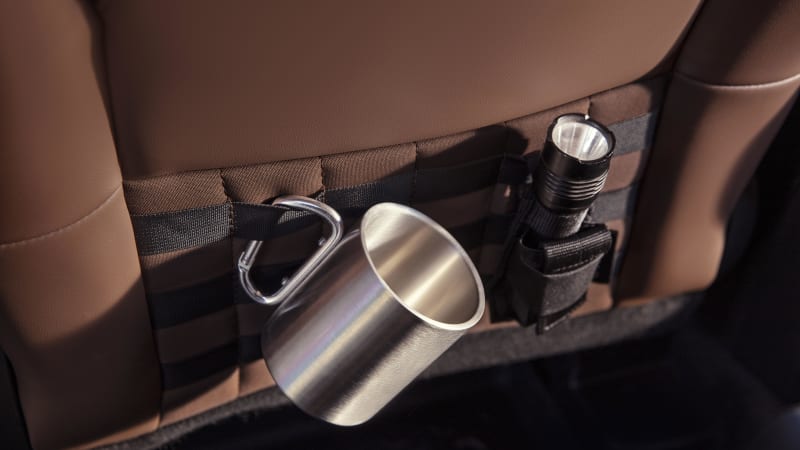
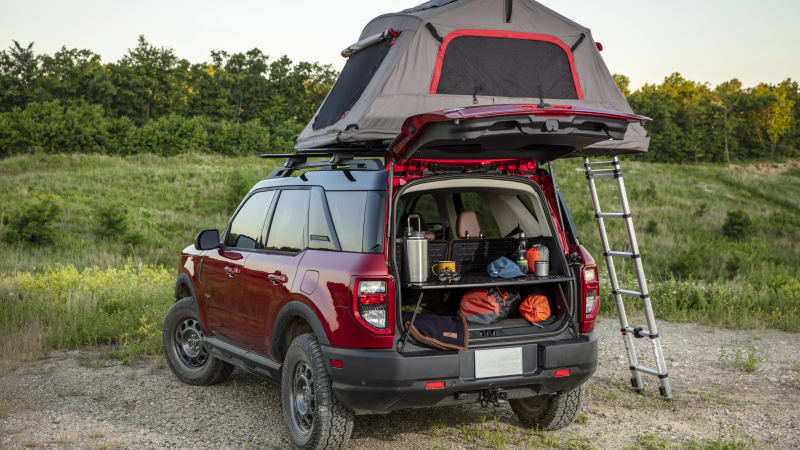
That's just some of the standard stuff. Starting with the Big Bend trim level (the second of four rungs, plus the special First Edition), the Bronco Sport's front seat backs have zippered pockets and a MOLLE strap system that lets you connect whatever you want or need. The seats are upholstered in easy-clean cloth, and the rear flooring is rubberized (in the Badlands trim, the entire cabin floor is rubberized and therefore wash-outable). An old-school bit of Ford tech also gets another day in the sun: The SecureCode access pad lets you lock the key in the car to prevent it from being lost or waterlogged out in the great outdoors.
Then there are the accessories. A Cargo Management System provides five configurations including a two-tier cargo floor and a slide-out tray that juts out to create a sort of tailgate prep station. The cabin and its stepped "safari" roofline was designed specifically to accommodate a bike rack accessory by Yakima that mounts two 27.5-inch-wheel mountain bikes inside. This is just one of the many design choices made after real-world research and a uniquely hands-on development program. In this case, they addressed a pain point for mountain bikers and cyclists concerned with security or the added hassle of mounting bikes onto the roof.
There are also four "lifestyle accessory bundles" dubbed Bike, Snow, Water and Camping, but Ford didn't actually explain what they included in the product information shared prior to the reveal. Nor was there an additional rundown of the "more than 100 factory-backed stand-alone accessories." In any event, it's clear that Ford had a clear idea of who it was designing the Bronco Sport for ó its designers and brand managers even made a point to go camping with it while in development.
Indeed, the dimensions are quite different. It's more than 3 inches narrower, the wheelbase is 1.6 inches shorter, and the overall length is so much smaller (172.7 inches versus the Escape's 180.5) that the Bronco Sport is considered a subcompact SUV. However, its track is an inch wider than Escape and itís a considerable 4 to 5 inches taller in height depending on trim level.
Moving beyond comparisons to Escape, the Bronco Sport's ground clearance depends on trim level, but all are higher than usual for a small SUV. The Base and Big Bend trims measure 7.8 inches, the fancy Outer Banks trim is 7.9 (likely due to bigger standard wheels) and the most-rugged Badlands manages 8.8 inches when fitted with the optional 29-inch all-terrain tires. That number is significant since it betters the 8.7 inches offered by the Jeep Cherokee Trailhawk and every Subaru SUV. How much it really matters in the field is highly debatable, but it looks good in a comparison chart.
With those big A/T tires, the Badlands' approach, departure and breakover angles are all roughly equivalent to those of the Jeep Compass and Cherokee Trailhawk (the Compass nips it in a few dimensions, but the bit Cherokee is always a bit behind). Water fording depth is superior to the Jeeps.
Then there are the accessories. A Cargo Management System provides five configurations including a two-tier cargo floor and a slide-out tray that juts out to create a sort of tailgate prep station. The cabin and its stepped "safari" roofline was designed specifically to accommodate a bike rack accessory by Yakima that mounts two 27.5-inch-wheel mountain bikes inside. This is just one of the many design choices made after real-world research and a uniquely hands-on development program. In this case, they addressed a pain point for mountain bikers and cyclists concerned with security or the added hassle of mounting bikes onto the roof.
There are also four "lifestyle accessory bundles" dubbed Bike, Snow, Water and Camping, but Ford didn't actually explain what they included in the product information shared prior to the reveal. Nor was there an additional rundown of the "more than 100 factory-backed stand-alone accessories." In any event, it's clear that Ford had a clear idea of who it was designing the Bronco Sport for ó its designers and brand managers even made a point to go camping with it while in development.
The underpinnings
Nevertheless, there is more going on here than a glorified hiking backpack on wheels. As has been widely reported, the 2021 Bronco Sport shares its platform with the 2020 Ford Escape and therefore the next-generation Ford Focus sold nearly everywhere but the United States. However, according to Chief Program Engineer Adrian Aguirre, "This is not an Escape with big tires."Indeed, the dimensions are quite different. It's more than 3 inches narrower, the wheelbase is 1.6 inches shorter, and the overall length is so much smaller (172.7 inches versus the Escape's 180.5) that the Bronco Sport is considered a subcompact SUV. However, its track is an inch wider than Escape and itís a considerable 4 to 5 inches taller in height depending on trim level.
Moving beyond comparisons to Escape, the Bronco Sport's ground clearance depends on trim level, but all are higher than usual for a small SUV. The Base and Big Bend trims measure 7.8 inches, the fancy Outer Banks trim is 7.9 (likely due to bigger standard wheels) and the most-rugged Badlands manages 8.8 inches when fitted with the optional 29-inch all-terrain tires. That number is significant since it betters the 8.7 inches offered by the Jeep Cherokee Trailhawk and every Subaru SUV. How much it really matters in the field is highly debatable, but it looks good in a comparison chart.
With those big A/T tires, the Badlands' approach, departure and breakover angles are all roughly equivalent to those of the Jeep Compass and Cherokee Trailhawk (the Compass nips it in a few dimensions, but the bit Cherokee is always a bit behind). Water fording depth is superior to the Jeeps.
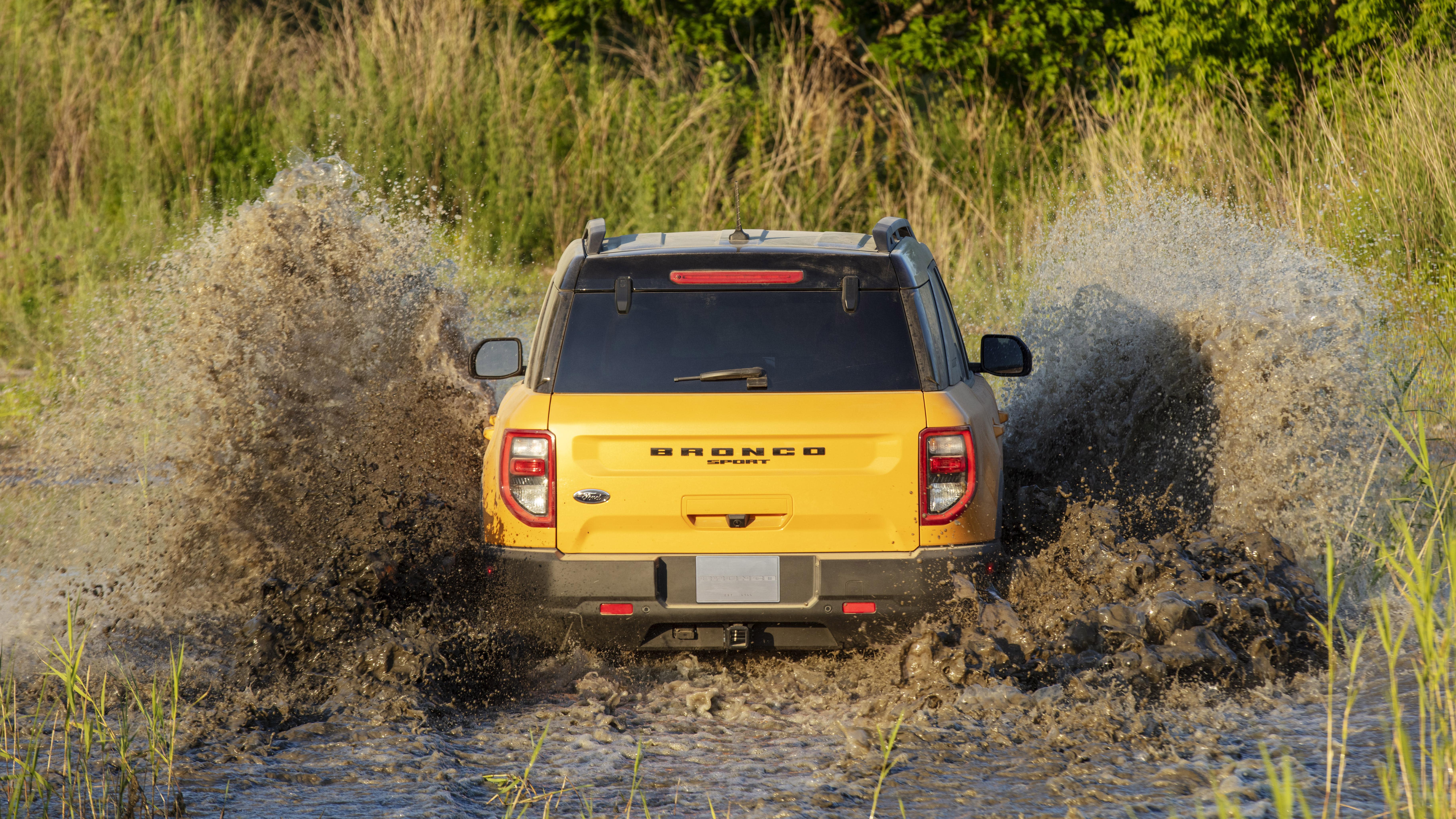
Powertrains and GOAT modes
Powertrains and GOAT modes
Standard on the Base, Big Bend and Outer Banks trim levels is a 1.5-liter turbocharged inline-three that produces 181 horsepower and 190 pound-feet of torque ó a greater output than the Escape's 1.5-liter triple. The Badlands and one-year-only First Edition get a 2.0-liter turbo inline-four good for 245 hp and 275 lb-ft, which is a huge amount for a subcompact SUV and even pretty rare among compact SUVs.
An eight-speed automatic transmission is standard and every Bronco Sport is described as having a "4x4 system." It's a safe assumption that it's really an on-demand all-wheel drive system, but there was no information provided about it in the pre-reveal press materials. However, we do know the Badlands and First Edition get an advanced system with a twin-clutch, torque-vectoring rear axle with a locking differential. Apparently, virtually all rear axle torque can be applied to one wheel.
Like its big Bronco brother, the Bronco Sport will come standard with GOAT modes (Go Over Any Terrain) that alter various vehicle parameters and settings to meet different terrain types. Standard are Normal, Eco, Sport and Slippery and Sand, while the Badlands and First Edition gain additional Mud/Ruts and Rock Crawl modes.
Experienced off-roaders may roll their eyes at such things, but chief engineer Adrian Aguirre noted that "many customers said that 4x4 systems are a mystery. They don't know how they work." That doesn't mean they're proud of that and could be perfectly willing to learn. As such, terrain-selectable drive modes like these and even the Bronco Sport itself can serve as a gateway to greater knowledge and involvement. Makes sense to us.
To that end, the Bronco Sport also offers Ford's Trail Control off-roading cruise control system that is also available on the full Bronco as well as Ranger. There's also a front-end camera available to make it easier to spot yourself in tricky situations.
Speaking of which, the Bronco Sport was subjected to an elevated degree of durability testing beyond the usual "Build Ford Tough" regimen of development. According to engineers, the Badlands greatly exceeded the capabilities normally expected of a crossover, but of course, we'll have to wait and test the extent of that claim.
It really would've been easy to cynically dismiss the Bronco Sport if it were just an Escape wearing Bronco clothes. However, despite sharing design cues with its big brother, it's also its own thing stylistically (take that safari roof, for instance) and possesses numerous functional design elements intended for customers who value interior capability more than wheel articulation and removable doors. The Badlands is likely to get the most attention due to its max capabilities and big motor, but to that target REI crowd, the lower trims still offer the distinctive stuff that could matter more.
Perhaps it won't be as impressive when we get to see and drive it in the flesh, but for now, the Bronco Sport seems to be able to stand outside the shadow of its big brother.
An eight-speed automatic transmission is standard and every Bronco Sport is described as having a "4x4 system." It's a safe assumption that it's really an on-demand all-wheel drive system, but there was no information provided about it in the pre-reveal press materials. However, we do know the Badlands and First Edition get an advanced system with a twin-clutch, torque-vectoring rear axle with a locking differential. Apparently, virtually all rear axle torque can be applied to one wheel.
Like its big Bronco brother, the Bronco Sport will come standard with GOAT modes (Go Over Any Terrain) that alter various vehicle parameters and settings to meet different terrain types. Standard are Normal, Eco, Sport and Slippery and Sand, while the Badlands and First Edition gain additional Mud/Ruts and Rock Crawl modes.
Experienced off-roaders may roll their eyes at such things, but chief engineer Adrian Aguirre noted that "many customers said that 4x4 systems are a mystery. They don't know how they work." That doesn't mean they're proud of that and could be perfectly willing to learn. As such, terrain-selectable drive modes like these and even the Bronco Sport itself can serve as a gateway to greater knowledge and involvement. Makes sense to us.
To that end, the Bronco Sport also offers Ford's Trail Control off-roading cruise control system that is also available on the full Bronco as well as Ranger. There's also a front-end camera available to make it easier to spot yourself in tricky situations.
Speaking of which, the Bronco Sport was subjected to an elevated degree of durability testing beyond the usual "Build Ford Tough" regimen of development. According to engineers, the Badlands greatly exceeded the capabilities normally expected of a crossover, but of course, we'll have to wait and test the extent of that claim.
The expected crossover stuff
In terms of regular old feature content, the Bronco Sport comes standard with an 8-inch Sync 3 touchscreen interface ó not the new Sync 4 system standard on the full Bronco. Apple CarPlay and Android Auto are standard. So too is the Ford Co-Pilot360 suite of driver assistance tech: forward collision warning with pedestrian detection and automatic emergency braking, blind-spot and rear cross-traffic warning, lane-keeping assist and auto high beams. Basically, the stuff that's expected on a compact or even subcompact crossover in the $20,000-$30,000 price range (exact pricing won't be available until closer to its on-sale date later this year, but reservations are now open).It really would've been easy to cynically dismiss the Bronco Sport if it were just an Escape wearing Bronco clothes. However, despite sharing design cues with its big brother, it's also its own thing stylistically (take that safari roof, for instance) and possesses numerous functional design elements intended for customers who value interior capability more than wheel articulation and removable doors. The Badlands is likely to get the most attention due to its max capabilities and big motor, but to that target REI crowd, the lower trims still offer the distinctive stuff that could matter more.
Perhaps it won't be as impressive when we get to see and drive it in the flesh, but for now, the Bronco Sport seems to be able to stand outside the shadow of its big brother.
#305
It's not all too different from where the Wrangler prices are at. Gladiator is even higher. And the trims all have available 2.7L EcoBoost V6, which the Wrangler doesn't really have an equivalent of, although they did just launch a diesel.
#309
#311
So.... I will be able to get hands on with a Bronco tomorrow for photos and quick videos (no driving at this time unfortunately). Don't know what spec the car will be, but if there are any specific requests I'll try to do my best. Time will be super limited I'm sure.
#313
I like this a lot, and figured I was interested enough to put down a deposit on one so did just that. Interested to learn more as the roll-out progresses, but so far I think Ford has done a great job with this.
#315
Ford did a nice job on bringing some of the retro elements into a new design. I think this will do well. I love that some models will come with 35" tires- that's awesome. Only thing that bugs me is that image where you can see the bronco logo on the nav screen. Things like that and the puddle lamps that have the car logo (Mustang for example) just bother me. I already know what I'm driving, not sure why I need to be reminded when approaching the car, turning it on, etc.




